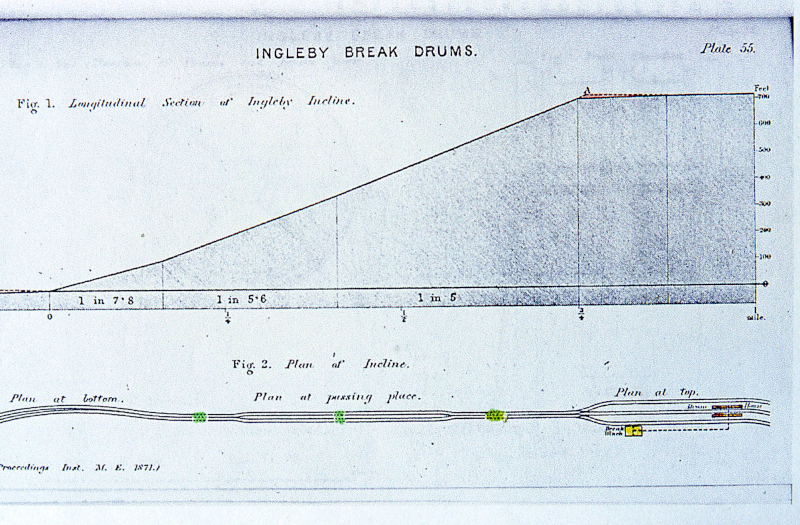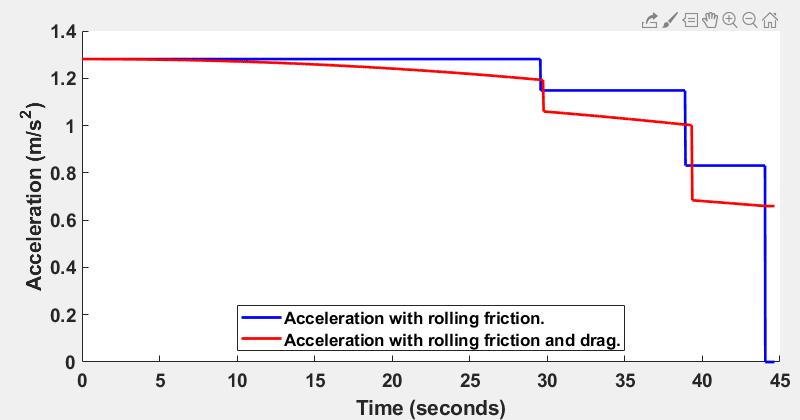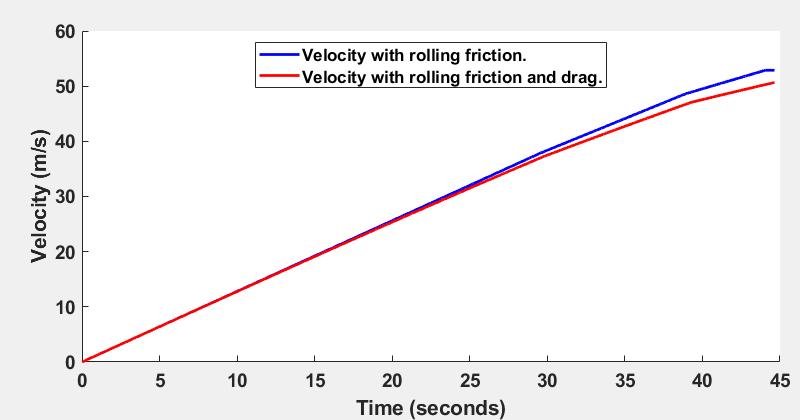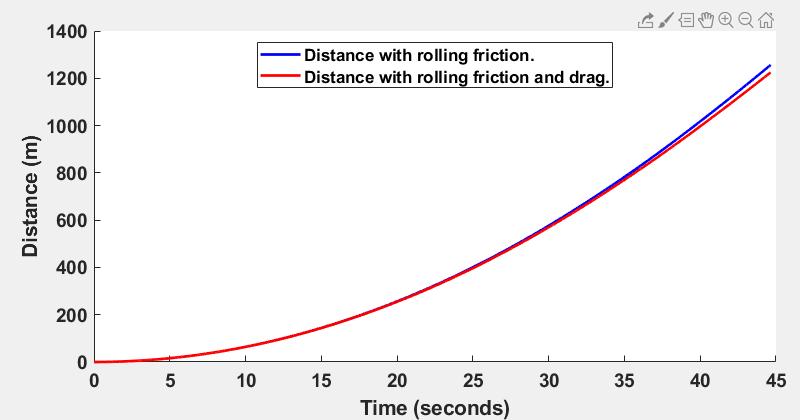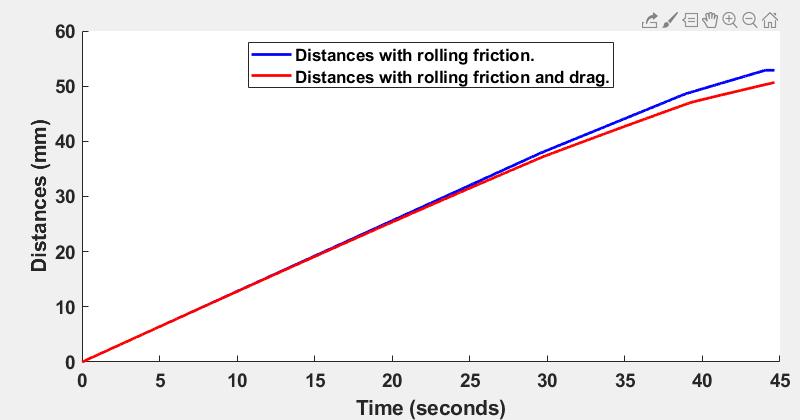Adrian Glasser – Land of Iron volunteer
This blog describes calculating the velocity of runaway ironstone wagons as they careened down Ingleby Incline when a cable snapped. To cut to the chase, without friction and wind resistance, the wagons would have reached a velocity of 154 mph, but more realistically, with friction and wind resistance taken into account they would have reached about 113.36 mph at the bottom of Ingleby Incline in about 44.65 seconds.
For reference to the map below, the bottom of Ingleby Incline starts on the branch of the path going off towards the bottom right of the section of map. Click on the '-' button to see the full extent of Ingleby Incline to the moor top.
Location of Ingleby Incline.
Grid Reference: NZ 60025 03478
Latitude, Longitude: 54.4232, -1.0764
Ingleby Incline is located about three miles from Battersby Junction and extends up the North York Moors escarpment. Today it is a lovely, but steep, footpath up the hill with wonderful views from the top. It used to be the site of an industrial railway where ironstone was brought down from the ironstone mines on the moors to the railways that carried it to the smelting kilns in Durham and beyond. The railway up Ingleby Incline was built in 1860 and consisted of a double set of tracks. From Incline Foot at the bottom, with a gradient of about 1 in 11, to Incline Top with a gradient of 1 in 5, the incline extends 1430 yards (1307.6 meters) to the moor top. Wagons loaded with ironstone, were lowered down the incline on steel cables 1650 yards long that went around a 14 ft break drum in the stone-built Drum House at Incline Top. The ironstone laden wagons were lowered, three at a time, while empty wagons or wagons filled with coal were pulled up the incline to partially counterbalance the weight on the adjacent tracks. It would normally have taken about 3 minutes for the loaded wagons to be lowered down at about 20 miles per hour.
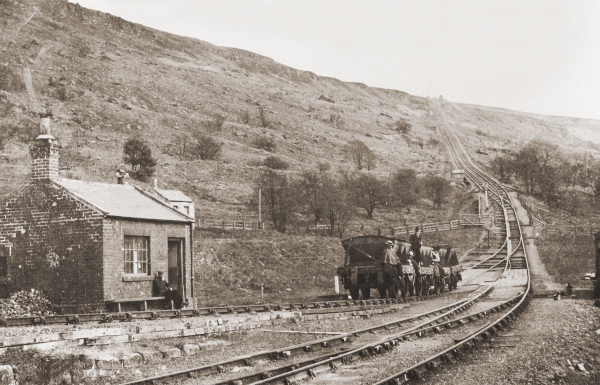
Occasionally, disaster struck when the cable snapped under the 50-ton weight of the loaded wagons full of ironstone and the wagons careened down the incline, either flying off the rails or smashing into stationary wagons on the tracks at Incline Foot. Although there were catch-points on the rails near the top and bottom to direct runaway wagons off the tracks, the wagons were not always successfully diverted off the main tracks to the safety of these catch-points. There are numerous old photographs of the carnage caused by these incidents and runaway wagons with smashed wagons, wagon wheels and piles of spilt ironstone beside the tracks. Old photographs also show the damage to the break house at the top caused by the tremendous whiplash from the tension released in the cable when it snapped. These dramatic incidents would have been memorable for the sheer terror caused by the snapped cable and the speed of the loaded wagons and the force and ferocity of their impact on anything in their way.
These photographs are courtesy of Ryedale Folk Museum and Beck Isle Museum archive and where noted on the photographs are photographed by T. W. Brotton. The photographs are thought to date from 1903.
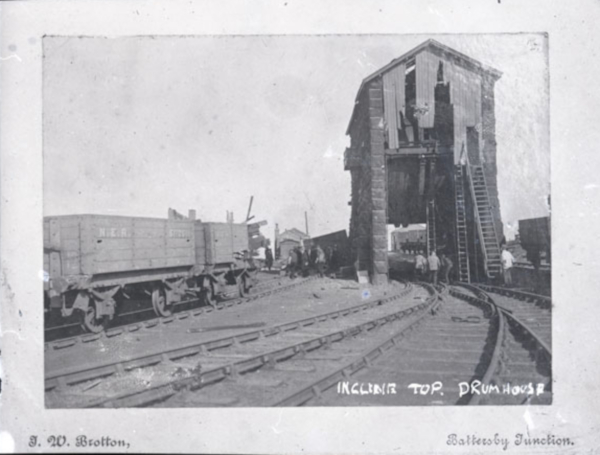
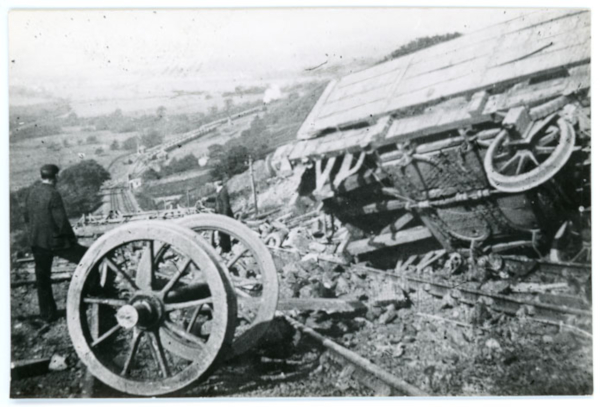
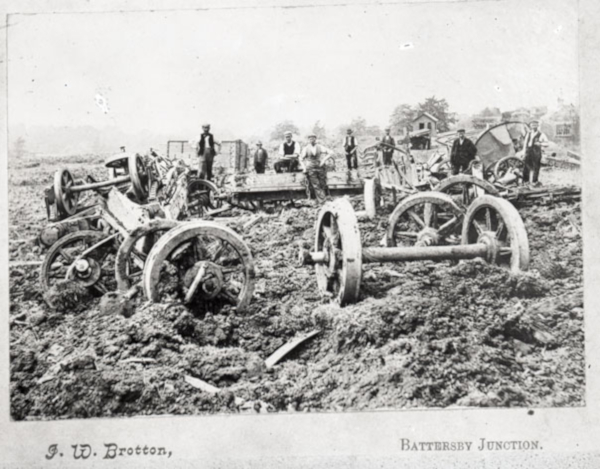

Tom, the Land of Iron Programme Manager, asked if it might be possible to calculate the speed reached at Incline Foot by a fully loaded set of runaway wagons from a snapped cable at Incline Top. There are good records of the length of Ingleby Incline and the gradients down the incline and with a few assumptions, it is possible to calculate the velocity. I did some initial calculations with some simplifications and assumptions;
Weight of the loaded ironstone wagons: 50 TDistance down the incline (\(d\)): 1225 meters
Acceleration due to gravity (\(g)\): 9.8 m/s2
Kinetic (i.e. moving) friction of the loaded wagons: 0
Initial velocity (\(vi\)) of the wagons at Incline Top: 0 m/s
Gradient of the incline: 1 in 5
If friction is neglect, the following equations can be used:
To find the final velocity (vf):
$$ {vf^2 – vi^2 = 2*a*d} $$
where \(vf\) is final velocity, \(vi\) is initial velocity, \(a\) is the acceleration and \(d\) is distance. This equation requires knowing the acceleration of the wagons and we can calculate the acceleration from:
$$ {a = g * sin(theta) } $$
where \(a\) is the acceleration down a slope, \(g\) is the acceleration due to gravity and \(theta\) is the angle of the gradient in degrees.
Notice, that in assuming no friction, acceleration due to gravity is constant and the acceleration of the wagons depends only on the gravitational force and the angle of the slope. The weight of the wagons is not actually used in this calculation. A gradient of 1 in 5 means a 1 m rise for a 5 m run. From this we can calculate the angle of the gradient in degrees. From: $$ {tan(theta) = opposite/adjacent} $$ the angle of the incline can be calculated to be: $$ {theta = arctan(opposite/adjacent) = arctan(1/5) = 11.31 \quad degrees} $$ Then from: $$ {a = g * sin(theta)} $$ the acceleration of the wagons can be calculated to be: $$ {a = 9.8 * sin(11.31) = 1.922 \quad m/s^2} $$ Then from: $$ {vf^2 – vi^2 = 2*a*d} $$ the final velocity can be calculated to be: $$ {vf = \sqrt(2*a*d +vi^2) = \sqrt(2*1.922*1225 + 0^2) = 68.62 \quad m/s} $$ $$ {68.62 \quad m/s \quad is \quad 247.04 \quad km/hour \quad or \quad 153.5 \quad mph} $$ Having calculated the acceleration and knowing the mass of the wagons (50,000 kg), the force generated by the accelerating wagons can be calculated to be: From: $$ {F = m * a = 96,100 \quad Newtons} $$ I presented this information to Tom and he shared it with some of the Land of Iron aficionados and one commented,
"Ah, yes, but what about the wind resistance of the wagons as they accelerated down Ingleby Incline. The resistance increases with the square of the velocity."
Further, the historical details of Ingleby Incline indicate that it was not a constant gradient of 1 in 5, but actually composed of three sections with three different gradients. So, could that be incorporated into the calculation? Further, the assumption of zero kinetic friction is not accurate, so could the friction be incorporated too? Kinetic friction is the friction when the wagons are moving. That would be the friction of the wheels on the tracks, of the wheels on the axles and on any bearings. Well, of course, with some assumptions and simplifications, it is possible to calculate the final velocity incorporating these factors too. However, this becomes somewhat more complicated because if the wind resistance is changing with the square of the velocity, then this means that as the wagons accelerate down the incline and the velocity increases, so too does the wind resistance and this then decreases the acceleration and so it reduces the velocity. This is a situation where something changes as a function of something else that changes. This is exactly what calculus is used for. There is another way to calculate something like this without resorting to calculus and that is to use a computer program. Computer programs are good because they do exactly what they are told to do (but this also means they are bad if they are told to do something wrong), but they are also good because they can do repeated calculations over and over again and generally don’t complain about doing that. The way to use a program to do these calculations is to do the calculations over and over again for very small increments. In computer programming this is called a loop. A loop is where the same calculation is repeated over and over again and the values at the end of the calculation on the previous iteration through the loop are passed to the start of the loop in the next iteration. As the wagons move down the incline, the time changes and the distance the wagons move down the incline change progressively. So, the program could do a loop around very small distance increments down the incline or the program could do a loop around very small time increments. For this particular calculation, it turns out that the best way to do this is as a function of time because at each time interval, the acceleration can be calculated, then the velocity can be calculated, then the drag (the resistance from wind resistance) can be calculated, then the new acceleration as slowed by the drag can be calculated and then the new velocity with the acceleration affected by drag can be calculated. If the new velocity is known at each time interval, the distance travelled over the time interval at that velocity can be calculated. So, by setting the time intervals to be something very small, like 0.001 seconds, these calculations can be performed over and over again as the wagons careen down the incline, adjusting the drag, the acceleration and the velocity at each new time interval, and calculating the distance travelled at each time interval. The assumption that is made in using a loop to do this in very small time increments is that the velocity is constant for each time increment. This is not true when acceleration is changing, but the smaller the time increments, the more accurate is this assumption. In using a computer program to do this, the time intervals could be made even smaller if needed, all that means is the entire calculation would take a little longer and there would be more iterations. If these calculations were to be done, then it is of interest to know how the acceleration, the velocity, the drag and the distances moved are changing as the wagons careen down the incline. Knowing these things would be interesting to see and they would be helpful for understanding if the calculations are correct, or if something goes wrong along the way. We can look at these numbers by plotting graphs of these numbers as a function of time. Further, if doing these calculations, the results with drag could be compared to the results calculated without drag. This would help to understand what the effects of the drag are. So, to be able to show all these results means that the numbers calculated at each time interval should be stored so they can be plotted when the calculations are completed. This adds one other consideration as to the appropriate time interval to choose, and that is, if very small time increments are used there will be many of them, so all the numbers from all the calculations at all the different time points will have to be stored and this increases the amount of memory that the program must use to perform these calculations and it affects how much data is available at the end of the calculations to display. The computations and the memory required for these calculations won’t be demanding on a computer program because programs can do far more demanding tasks than this, but to keep it reasonably simple, it would be better not to use too small a time increment. There are some other considerations as to what time interval to use. The iterative calculations assume that acceleration is constant at each time interval. This is not in fact correct as acceleration is constantly increasing (and changing with drag) even during each time interval. This does add some inaccuracies that calculus does not suffer from, but, so long as the time intervals are small enough, the inaccuracies caused by this compared to what would be calculated with calculus, will be acceptable. There are, in fact, many inaccuracies in these calculations, because it is not possible to know the true friction of the wagons and it is not possible to know the true drag from wind resistance. Wind resistance is affected by the turbulence of the air flow over the wagons, how long the line of wagons is, how aerodynamic (or not) the wagon are, etc. It is virtually impossible to know all these details and many of them would have to be established by doing actual testing with scale models to know them more accurately. The programming language I have chosen to do these calculations in is Matlab because it is the programming language I have most experience with and I know it better than I know the several other programming languages I use from time to time. A programming language is just like a language in many ways. The more one knows it, the more fluently one can speak it and the more elegant one’s conversations are. It's just the same with a program. The better you know a programming language, the better the program will be. There are many freely available programming languages like Python or Processing, for example. They would work perfectly well too. An engineering image of Ingleby Incline exists which shows the gradients, the distances and the overall heights of Ingleby Incline. It is useful and a valuable resource, but the image suffers from the disadvantages that it is not perfectly horizontally oriented and the horizontal and vertical axes are not the same scale.